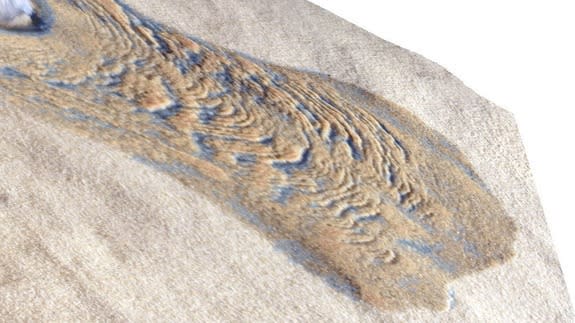Boiling water on Mars may create channels on the red planet

Much of what we know about Mars we have learned from looking at its complicated, sometimes confusing surface features.
In 1813, astronomer Honore Flaugergues suggested that Mars was warmer than Earth because he observed the red planet’s polar ice caps melting in the summer months.
Later that century, some scientists using Earth-based telescopes championed the idea that darkly colored channels on Mars were canals potentially built by intelligent life.
SEE ALSO: NASA says liquid water may flow on Mars. What does it mean for life?
Today, we know that those “canals” are natural features crafted by geology on Mars, and the red planet is both far colder and far drier than Earth. Such insights have come from Earth-bound experiments and observations from spacecraft on Mars.
Those observations give scientists a good idea of the processes occurring on the planet today and how the world’s features were sculpted in the past.
A new study in the journal Nature Geoscience could help further refine exactly what’s going on with water on Mars. The new research suggests that Martian water is actually boiling off the surface of the planet due to the world’s thin atmosphere, and that this is disturbing dust particles.
That disruption, while improbable on Earth because of our planet's thick atmosphere, may be the reason long, dark streaks of what look like flows of liquid water grow on Mars during the warmer spring months.
A Martian lab on Earth
Scientists used lab experiments simulating the Martian dirt to show that water boiling off Mars can change the planet’s surface features, possibly accounting for some of the streaks we see on the surface of the red planet.
In 2015, scientists announced that data from the Mars Reconnaissance Orbiter has found that the dark streaks seen during the warmer months are signatures of briny water — basically wet salts — that become liquid and flow downhill very slowly.
That kind of streaking is an analogue for what happens on Earth when water flowing downhill darkens a slope as it moves, for example.
The new study suggests that the thin Martian atmosphere with low air pressure allows water to boil away when it becomes liquid briefly on the surface of the planet.
On Earth water boils at different temperature depending on altitude, since that affects atmospheric pressure. Higher elevations have lower pressure readings, and water boils at a lower temperature there.
On Mars, atmospheric pressure all over the planet is incredibly low, meaning that water cannot stay stable on the surface of the red planet for long, potentially boiling away and evaporating into the atmosphere just after becoming liquid during the warmer months.
As the water boils off, it can produce piles of sand grains that eventually collapse, potentially creating the “channels” seen on the red planet, the study says.
“Instead of requiring the stability of substantial water or brines, it is the instability of water on Mars that may explain the morphological activity needed to form the observed features,” planetary scientist Wouter Marra wrote in a News and Views piece accompanying the study.
Let Mars be Mars
Scientists know that these streaks of seeping, salty water on Mars change with the seasons, but they aren't exactly sure how they evolve.
"I think what this paper is showing is that it's not just necessarily the action of the water itself, it's the transition of that phase in the Mars environment where that water is actually boiling away into the atmosphere, and that produces a mechanical agitation that can produce what these things look like," NASA’s Rich Zurek, project scientist for the Mars Reconnaissance Orbiter, told Mashable in an interview.
This new lab experiment doesn’t necessarily negate those liquid water findings from last year, but it does help scientists see Mars as a more cohesive system instead of just looking at it as an Earth analogue.
"It really demonstrates that we have to take Mars as it is, not as our Earth analogues might suggest it is," Zurek, who is unaffiliated with the new study, said.
"Water being at the edge of this stability translation between solid and vapor and possibly transient liquid, that's pretty unique to Mars and yet it may be very fundamental to understanding how Mars is today and how it got that way over time."
Scientists may get a better idea of what is really creating these streaks on Mars when Europe’s ExoMars mission arrives in orbit around the red planet in October.
Zurek said that it's possible that this spacecraft will help determine whether water is boiling into the atmosphere or seeping by looking at the streaks and the temperature of the planet over time.
